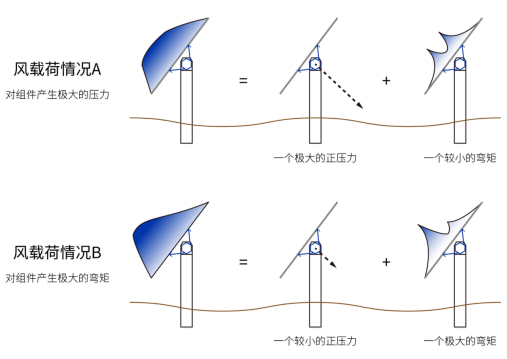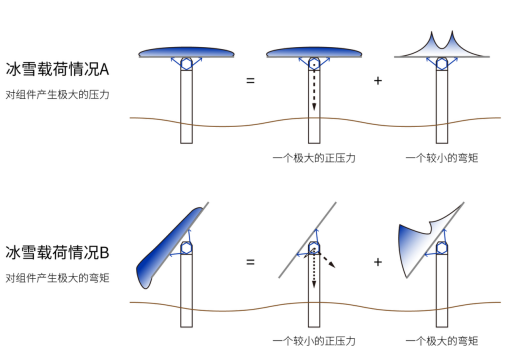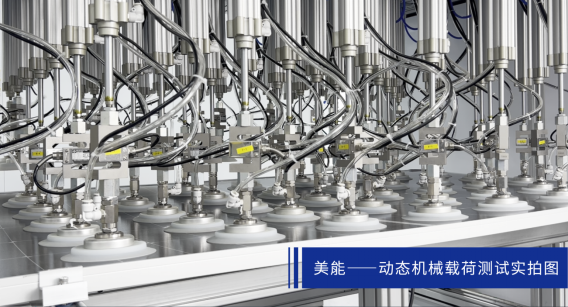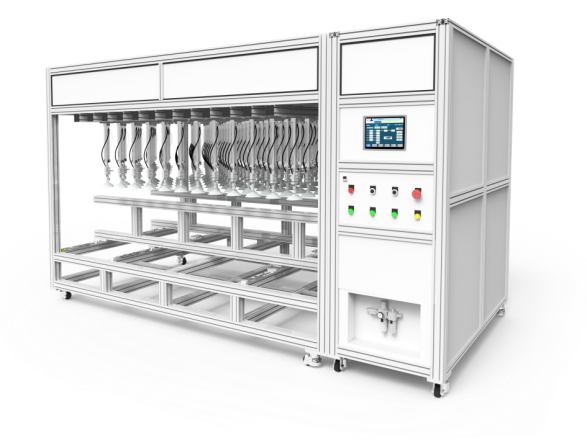
量子效率测试仪
PL/EL一体机
Sinton硅片少子寿命测试仪
Sinton硅块少子寿命测试仪
绒面反射率测试仪
3D共聚焦显微镜
清洗制绒工作站
在线四探针方阻测试仪
全自动扫描四探针方阻测试仪
在线薄膜厚度测试仪
晶化率测试仪
Horiba显微共焦拉曼光谱仪
傅里叶红外光谱仪
霍尔效应测试仪
分光光度计
全光谱椭偏仪
Horiba椭圆偏振光谱仪
TLM接触电阻率测试仪
超景深显微镜
网版智能影像测量仪
全自动影像测量仪
卧式拉力机
电池片稳态光衰老化试验箱
电池片紫外老化试验箱
电池片拉脱力综合测试仪
外观检验台
湿漏电测试系统
组件实验室EL测试仪
紫外老化试验箱
稳态光衰老化试验箱
电流连续性监测系统
PID测试系统
旁路二极管测试系统
LeTID测试系统
反向电流过载系统
脉冲电压测试系统
绝缘耐压测试仪
接地连续性测试仪
绝缘耐压接地测试仪
湿热环境试验箱
湿冻环境试验箱
热循环试验箱
动态机械载荷测试机
静态机械载荷测试机
冰雹冲击试验机
引出端强度试验机
霰弹冲击试验机
抗划伤(切割)测试机
剥离试验机
万能材料试验机(单臂)
万能材料试验机(双臂)
光伏玻璃透过率测试仪
醋酸测试试验箱
交联度测试系统
二极管接线盒综合测试仪
落球冲击试验机
半自动四探针
全自动探针式台阶仪
多通道太阳能MPPT系统
Horiba稳瞬态荧光光谱仪
钙钛矿P1激光划线测试仪
钙钛矿在线膜厚测试仪
钙钛矿工艺检测工作站
手持式IV测试仪
便携式EL测试仪
手持热成像测试仪
户外组件IV测试仪
户外组件多通道测试系统
光伏逆变器电能质量测试仪
无人机EL检测仪
机械载荷测试模拟光伏组件在实际应用过程中抗风压、抗冲击能力
日期:2024-05-17浏览量:25
光伏组件的日益高功率化、组件尺寸增大成为趋势,组件在工厂处理、运输、安装过程中会收到各种各样的力,在户外会受到风、雪、冰等重物的压力,如果组件的强度达不到要求,在受到重物压力情况下,组件形变过大,会导致出现电池片和主栅等脆弱部分失效现象。美能动态机械载荷测试仪被广泛应用于光伏组件的结构设计和评估,通过使用机械应力以模拟实际情况下的外力作用,评估组件在自然环境条件下的抗风压、抗冲击能力以及结构的稳定性。

在全球光伏实验室检测通行的光伏组件性能及安全测试规范IEC标准中,对于机械载荷测试进行了详细规定,例如IEC TS 62782用于评估光伏组件承受动态风压的能力,以及IEC 61215中MQT16的机械载荷试验。
光伏组件风载荷
光伏组件在实际使用过程中遭受大风天气而损坏的情况并不少见,风载的作用虽然不如其他自然灾害那样强,但是风载荷作用频繁且受外界环境和结构形式的影响不易确定,对光伏组件产生的危害要大得多。在光伏发电系统中,光伏组件是最先承受风载荷的,其占据了大部分的受力面积,之后再传递至基础结构(地基、配重等)。

两种不同的风载荷工况对组件产生了两种不同的力
光伏组件冰雪载荷
冰雪在组件表面大量堆积时,会造成压力。通过机械载荷测试评估光伏组件在遇到强降雪时,承受压力的能力,从而更有效规避将组件产品应用在多降雪地区,进而造成积雪压力引起的组件失效情况,如边框弯折或断裂、背玻不均匀性破裂、安装系统部分或完全解体等。

两种不同的冰雪载荷工况对组件产生了两种不同的力
机械载荷测试
光伏组件在进入实地使用之前,为了避免出现各种故障与失效情况,必须保证光伏组件的结构设计合理、材料选择合理、生产工艺流程合理,且经历一系列的气候、光照、电气和机械应力测试。
其中机械应力测试,包含静态、动态机械载荷试验,引出端强度试验和冰雹撞击试验。
静态机械载荷,IEC61215对其的要求为至少达到设计载荷的1.5倍,通过施加一定的载荷并测量组件的位移、应力等参数,可以确定组件最大承载能力,以及变形特性。这对于设计和选择适合特定应用场景的光伏组件非常重要,以确保其在实际工作中能够安全可靠地承受外部机械载荷。
所谓动态机械载荷,是指光伏组件在强风作用下,产生前后表面晃动,会使得组件承受正反方向交替加压,从而加速材料疲劳,进而可能引发电池片和栅线等脆弱部分的失效现象。影响强度的关键因素有组件的尺寸、厚度、表面处理、框架稳定性、安装方式和焊接点的机械可靠性。测试有助于评估组件的抗疲劳性能和材料的耐久性,提高产品质量水平。

现有标准中机械载荷试验主要模拟组件承受静态载荷的情况,考核组件在静止不变的压力下是否可靠。动态机械载荷比静态机械载荷更加苛刻,更能够客观、全面的反映组件的真实可靠性,是制造商测量光伏组件抗风能力的绝佳工具。

未合格组件在动态机械载荷试验前(左)后(右)EL图像对比
美能动态机械载荷测试仪

联系:400-008-6690
美能动态机械载荷测试仪,兼具静态机械载荷测试和动态机械载荷测试2套测试功能,测试光伏组件在经受风、雪、或覆冰等静态、动态载荷的抗压能力。采用动态持压技术,模拟组件承受正反方向交替加压试验,加速组件材料疲劳,检验组件的真实可靠性。载荷施加方式:气缸带动吸盘压合吸;
具备84(12*7)个气缸,每个气缸单独控制;
测试系统压力,拉力,保持时间,循环测试,循环频率,电流大小可以预先设定;
测试系统可记录和存储测试过程中的正向压强,反向压强,形变,温度,循环次数,电流值。




































































